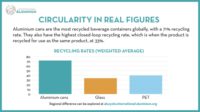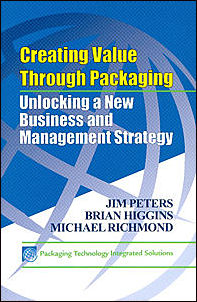Labeling: Inks and Coating
The Value of Inks & Coatings in a Circular Economy
How recyclability, bio-renewability and compostability play a critical role.

In a world where sustainability is a top priority, brand owners in every industry are positioning their brands as environmentally friendly. From food production to packaging, even price may be taking a back seat to sustainability when it comes to consumer demands.
A study by the Flexible Packaging Association in 2018 concluded that 72% of brand owners believe consumers care about the sustainability aspects of packaging materials. In fact, 79% of consumers say that they prefer products that are in sustainable packaging over those that are not.
Some countries and world organizations are taking it upon themselves to make the world more sustainable. The United Nations, for instance, introduced its initiative, “Transforming our World: the 2030 Agenda for Sustainable Development,” a plan that highlights 17 UN goals for decreasing the carbon footprint.
Brand owners are joining the cause and finding that if they take the time to listen to consumers and their sustainability concerns, and then take the necessary steps to vet and study the environmental practices implemented by their suppliers and partners, they will be rewarded for their efforts.
There are three components that could play a critical role in the sustainability of packaging — recyclability, bio-renewability and compostability. Each of these plays a specific role in the circular economy and decreasing the carbon footprint.
Recyclability
The world currently runs predominantly as a linear economy, meaning that natural resources are used and then disposed of. With the aggressive shift toward becoming a circular economy, natural resources would be used, broken down and recycled for use again and again.
For example, in a circular economy, a polyethylene terephthalate (PET) bottle with a shrink label affixed could be used, the label de-seamed and the bottle recycled, allowing those same raw materials to be used repeatedly.
The label itself can affect the recyclability of the bottle, and furthermore, the inks and pigments used can impact the recyclability of the label. Brand owners must do their due diligence to understand how their converter partners are contributing to the overall process.
The label should first be stripped off the PET substrate, assuring that it doesn’t interfere with the breaking down of the plastic into pellets to be used again in the circular economy. Otherwise, the label itself and its components, such as the inks and pigments, can potentially contaminate the pellets that are made from the bottle.
Solutions in the marketplace enable brand owners to increase the recyclability of their products that use shrink labels. Currently, offerings exist that provide solvent-based, de-seaming adhesives that replace the traditional solvent seam on the label, allowing easy removal during recycling for an improved, label-free process for recycling PET containers.
De-seaming allows brand owners to continue to use shrink labels, without sacrificing quality packaging or sustainable values as they are contributing to the overall recyclability of the PET bottle.
Another way to recycle inks and contribute to a circular economy is to utilize a water-based flexo dispenser. Using a dispenser allows printers to mix exactly the amount of water-based flexo inks that they need, reduce their inventory and waste, improve color-matching consistency and significantly decrease total operating costs.
Label printers traditionally have to remove ink-soiled containers. For printers with large volumes of leftover ink on their shelves, the water-based flexo ink dispenser creates the ability to mix and match leftover inks and give the color needed within the delta E — thus, reducing inventory and waste.
Bio-renewability
There are several components of the label that are considered contaminants that impact the recycling process — inks and pigments included. There are procedures that help to minimize the impacts of these contaminants, but the more eco-efficient the substances are, the easier the recycling process will be and the more sustainable the process becomes. Bio-renewable inks based on renewable natural resources and new eco-friendly materials can play a key role in how sustainable a package may be.
It is important that claims of bio-renewable materials are verified by a separate third-party lab to avoid misconceptions and false claims. The National Association of Printing Ink Manufacturers (NAPIM) has a comprehensive program to verify bio-renewable claims and help ink manufacturers with their verification needs.
According to NAPIM, bio-renewable inks are derived from tree, plant, insect, and/or animal materials. These include gums, resins, waxes, solvents, oils, and other polymer building blocks. Independent verification that an ink contains a certain percentage of bio-renewable content can be achieved through NAPIM’s bio-renewable content program, which assigns inks with an index number. An index number of 60, for example, means that the ink contains 60 percent renewable content.
Compostability
Compostability refers to the ability of materials to biodegrade naturally within a specified timeframe under controlled conditions. The overall compostability of a package, labels included, directly relates to its components — inks, substrates, and more — which must comply with set rules determined by region.
The ink itself would be considered an “additive,” meaning it does not exceed a certain percentage in weight. While additives are not expected to play an active part in the composting process, they still undergo strict eco-toxicity and chemical analysis tests carried out by independent accredited laboratories to make sure that they don’t negatively affect the process by introducing contaminants which would affect plant growth.
Furthermore, brands can ensure they are working with a partner who is certified by the Biodegradable Products Institute (BPI), DinCertco or TUV Austria. These are private certification bodies that carry out laboratory tests on the finished packaging product, or on its separate components (including the inks), to prove that it fully meets the European EN 13432 or North American ASTM D6400 and D6868 compostable criteria standards. If BPI-certified, for example, the material used is considered compostable without leaving any toxins or plastic residues in the soil.
To receive the certification, three tests are conducted to understand if the material meets standards. The first is to understand if the material can be converted to carbon dioxide by organisms already at a compost pile in a reasonable timeframe. The second tests the ability to fragment, meaning the products do not clog screening equipment. The third tests the material and its ability to support plant growth.
Brands can be certain that using partners who are certified will ensure the materials used will biodegrade completely when composted.
The Role of Other Inks and Solutions
Energy curable inks can also play a role in sustainability efforts. While energy curable inks are traditionally cured with mercury lamps, new technology allows for an eco-friendlier alternative—LED lamps. This energy-efficient technology is an option that quicker and results in reducing the carbon footprint in the overall printing process. Inks were developed for LED curing that both meet food and safety standards and print at the highest quality.
Another alternative is water-based inks, which are used when UV-inks cannot. Many water-based inks incorporate 80 percent plant-based or natural materials and utilize natural resins and mineral-based colorants.
Other solutions offer printers the ability to mix only the inks they need, ensuring that they are using the right kind and the right amount of ink for each print. Managing the overabundance of ink used makes it so less ink is wasted throughout the entire printing process.
By introducing bio-renewable and compostable inks, brand owners can improve the sustainability of their converting operations without sacrificing cost or performance. The impact is almost immediate, helping brands to reduce the carbon footprints of their printing operations.
Whether it be adopting a more bio-renewable or compostable ink or adding adhesives that can contribute to the recyclability of a plastic bottle, partnering with an environmentally friendly ink manufacturer can contribute to a brand’s goal of becoming more sustainable.
Looking for a reprint of this article?
From high-res PDFs to custom plaques, order your copy today!







